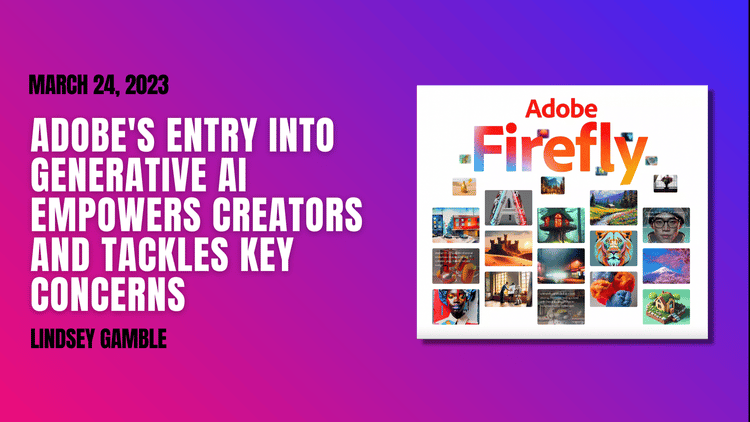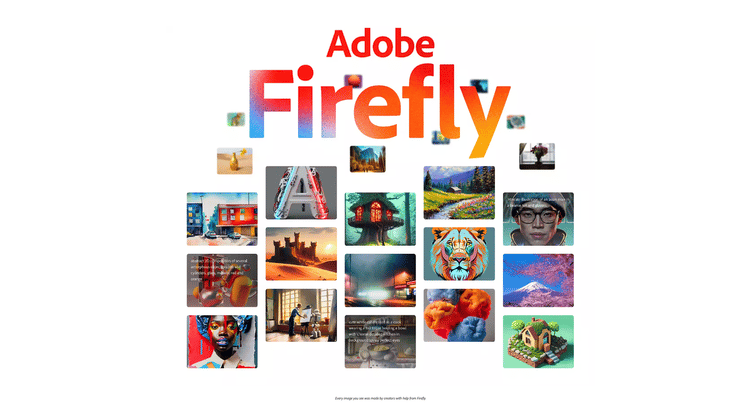
Yesterday, TikTok CEO Shou Zi Chew made his first appearance before Congress. As TikTok faces a potential ban in the US, Chew defended the company and answered questions about its privacy policies, content moderation, and impact on children, among other topics. After the four-and-a-half-hour hearing, it appears that bipartisan support is strong, and something will likely happen, whether that be a TikTok ban or the company being sold to a US company. Let’s hope that isn’t the case, but what do you think?
On another note, I will be attending TikTok's Creative Partner Day event in LA next week. If you are also attending or in the area, let me know — I’d love to say hi.
Today’s Edition:
Adobe enters the generative AI space with Adobe Firefly
Instagram offers more ad options for brands with Reminder Ads and Ads in Search Results
TikTok's upgraded community guidelines require disclosure of AI-generated or manipulated content
Adobe Enters the Generative AI Space with Adobe Firefly

Adobe has entered the generative AI space with Adobe Firefly a new family of creative, generative models that will eventually be integrated into its suite of apps, including Adobe Express, Photoshop, and Illustrator.
How Firefly Works
During its beta launch, available on its website, creators can produce high-quality images and text effects using text prompts. These initial models are trained on Adobe Stock images, which are openly licensed and public domain content, meaning they are safe for commercial use.
Content generated using Firefly will include metadata that indicates it was produced with AI, either fully or in part. In the future, creators will also be able to tag their content with "Do Not Train" to prevent it from being used to train models. Additionally, Adobe is working on a compensation model to reward creators who contribute to Adobe Stock content, following its strategy with Adobe Stock and Behance, with more information to be released soon.
Other upcoming features include Personalized Results, which enables users to create images based on their personal objects or styles, Inpainting, which facilitates the addition, removal, or replacement of objects in an image with a text prompt, and 3D to image, which generates pictures from interactive positioning of 3D elements.
What Firefly Means For Creators
Firefly builds upon Adobe's existing AI features. With Firefly, creators can use everyday language to create high-quality content in various formats. What makes Adobe attractive is that its products and services are already an integral part of most creators' toolkits and workflows, whether it's using Lightroom for photo editing, Premiere for video editing, or Behance for showcasing their work. Instead of having to use other generative AI tools like DALL-E 2 and Midjourney and then importing the results into Adobe's apps for adjustments and finishing touches, creators will eventually be able to effortlessly merge generative AI and standard editing tools within Adobe's suite of apps.
Why Adobe’s Approach to Generative AI Differs
Adobe's approach to generative AI differs from other players by tackling major concerns about generative AI, such as copyright issues, ethical and responsible use of AI, and creator compensation. Plus, Adobe is being transparent about its AI training models, something that many competitors aren’t currently doing. Although Adobe may have taken longer to join the generative AI trend, its approach represents a company that wants to empower creators further, but in the right way.
Instagram Offers More Ad Options for Brands with Reminder Ads and Ads in Search Results
Instagram has announced two new ad options: Reminder Ads and Ads in Search Results. The former allows brands to run in-feed ads to increase awareness of upcoming events and launches by sending opt-in reminder notifications, while the latter enables brands to reach users who are actively searching for products, brands, or content, similar to TikTok’s Search Ads.
These options offer brands greater opportunities to engage with their target audiences, but could increase the ad load on the platform, which users won’t like. Despite this, Instagram is investing in new advertising solutions to attract brands, as Meta is struggling to maintain its ad revenue.
Instagram Starts to Display Share Counts for Reels Content
Instagram has started showing the share counts for Reels to some users. Now, when viewing a Reel, the number of times it has been shared is displayed along with the number of likes and comments.
With this update, creators and brands have another metric to consider when measuring the success of Reels content. Videos with a significant number of shares can indicate how much they are resonating with viewers. TikTok has long displayed the number of shares for videos, which likely influenced Instagram to start doing the same, as well as Twitter's recent display of the number of bookmarks a tweet gets.
TikTok's Upgraded Community Guidelines Require Disclosure of AI-Generated or Manipulated Content
TikTok has updated its community guidelines, which will go into effect on April 21st. One of the notable updates is that creators and brands must clearly disclose AI-generated or manipulated content. They can do so by using a sticker or, in the caption, using phrases like "synthetic," "fake," "not real," or "altered."
These updates are part of a series of changes made by TikTok over the past few months to create a safer environment on its platform. With platforms like TikTok, Instagram, and YouTube becoming such a big part of everyday life, they have no choice but to continue updating their guidelines and policies in ways that protect users while balancing creative expression.
Twitch Faces Challenges Under New Leadership Following CEO Resignation and Layoffs
Emmett Shear, the CEO of Twitch, has resigned to spend more time with his family. His resignation was followed by Amazon laying off 400 Twitch employees, causing upheaval for the platform.
Some creators hope for positive changes under former President now CEO, Dan Clancy. However, his past decisions, such as the controversial revenue split change, have caused concern. Clancy could benefit from following in the footsteps of YouTube's new CEO Neal Mohan and spending time with creators to understand their needs as he begins his tenure.
CapCut, ByteDance's Video Editing App, Surpasses 200 Million Monthly Active Users
CapCut, a video editing app owned by ByteDance, has surpassed 200 million monthly active users. The app is popular among creators for its editing tools and is used to produce videos for TikTok, Instagram, and YouTube.
This milestone comes at a time when TikTok is facing scrutiny from governing bodies worldwide. A potential TikTok ban in the U.S. could also result in a ban for CapCut, Lemon8, and other ByteDance apps.
Flipboard Launches Pinned Flips to Help Creators Showcase Prioritized Content
Flipboard launched Pinned Flips, a new feature that allows creators to pin content to the top of their Magazine, ensuring that it’s the first thing viewers see. Creators can pin anything they add to a Magazine, including a Note, an article, or a video.
This feature follows the recent launch of the platform's new creator programs, which aim to support creators with promotion, community-building, and economic growth.
Levi’s Turns to AI-Generated Models to Show Shoppers More Diverse Models
Levi's has announced a partnership with Dutch digital studio LaLaLand.ai to introduce AI-generated models on its e-commerce pages, with the aim of showcasing a more diverse range of models to shoppers. While the brand intends to prioritize hiring more diverse human models, it says that it may not be feasible to represent every possible combination of race, ethnicity, age, body size, and body type.
The move highlights how AI can be both beneficial and controversial, as it could offer a more inclusive shopping experience for consumers while potentially taking jobs away from human models.
Soulcial Scoop Podcast: 4 Unconventional Ways for Creators to Work with Brands

I recently appeared on the Soulcial Scoop podcast with Kristen Bousquet, who teaches entrepreneurial creators how to turn their online influence into a profitable, self-sustaining business.
During the episode, we explored different ways that creators and brands can collaborate beyond sponsored content, as well as the benefits of doing so for both parties. If you're a creator looking to pitch new partnership ideas to brands or a marketer seeking to take your influencer program to the next level and make it more comprehensive, check out the episode on your favorite podcast player here.
What I’m Reading
The 10 craziest moments from Congress’ TikTok ban hearing (Gizmodo)
Short-form video needs better monetization, creator funds aren’t the way to do it (Digiday) I’m quoted in this piece
Utah law could curb use of TikTok and Instagram by children and teens (New York Times)
How Twitch lost its way (Washington Post)

